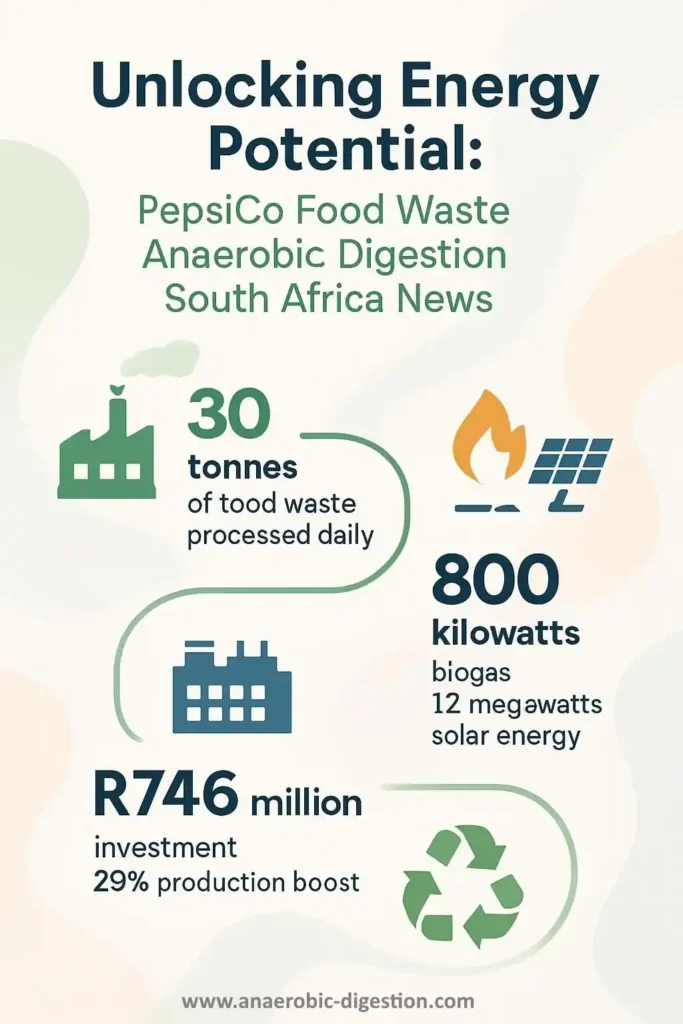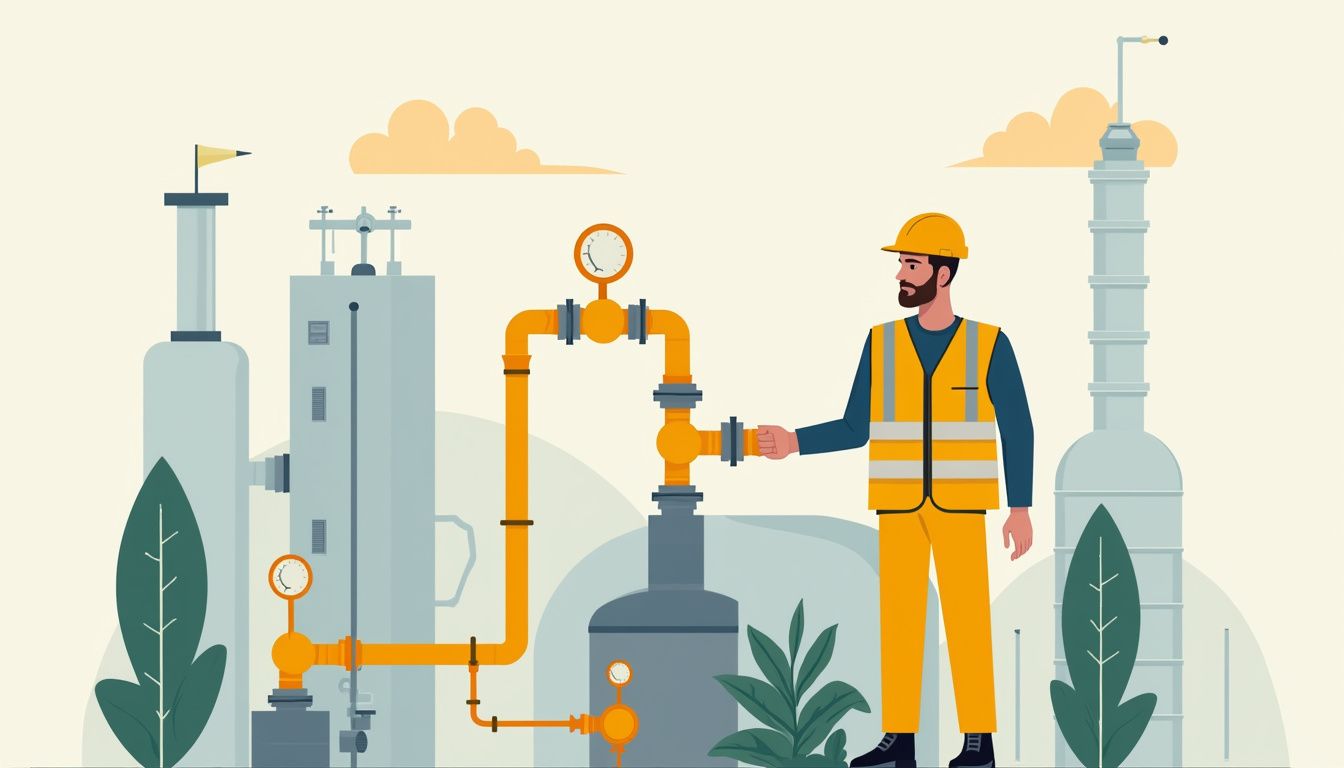Pepsico Food Waste Digestion Unlocks Energy Potential in South Africa via Anaerobic Digestion
At PepsiCo South Africa's Isando facility in Gauteng, food waste does not go to rubbish dumps. They use a Food Waste Anaerobic Digester to turn their garbage into biogas instead of letting it rot away unused.
This process gives the plant clean energy and even cuts carbon emissions by capturing methane before it escapes.
PepsiCo South Africa describes its Isando facility in Gauteng as a “beacon of sustainable innovation,” with an on-site anaerobic digestion system that converts trash into biogas and generates up to 30% of the site's peak energy needs.
This comes after the firm introduced its new potato chip production line, the PC50 Flex Line, in which it invested R746 million last year.
PepsiCo referred to the plant as the “cutting edge” of South Africa's snack production scene.
Isando, which manufactures brands such as Lay's, Simba, NikNaks, and Doritos, is stated to exemplify PepsiCo's dedication to world-class production, environmental responsibility, and local economic empowerment.
Gareth Haarhoff, General Manager of PepsiCo South Africa Snacks, described the local snacks business as resilient, with consistent increase in volume and income over the last decade.
This blog will explain how anaerobic digestion transforms uneaten snacks, potato peelings, and other organic materials into power. You will also learn how this site helps create jobs while cutting pollution with its new renewable natural gas system.
If you're curious about fighting climate-warming problems using science and getting more out of everyday trash, keep reading!
Key Takeaways
- PepsiCo's Isando facility in Gauteng turns 30 tonnes of food waste daily into clean energy using an on-site anaerobic digester, meeting up to 30% of its peak electricity needs and cutting carbon emissions by capturing methane (CH4).
- The plant uses codigestion with food scraps, animal manure, greases and sewage sludge. It produces 800 kilowatts from biogas and 1.7 megawatts from solar panels for operations, supporting South Africa's pollution prevention goals.
- PepsiCo invested R746 million in the PC50 Flex Line at Isando, boosting potato crisp production by 29%. This created 103 direct jobs and over 2,000 indirect opportunities for local small businesses (SMMEs).
- Since 2023-2024, the site has achieved zero waste to landfill and reached full water replenishment; this supports local communities while setting a benchmark for sustainable snack manufacturing across Africa.
- Snacks like Lays, Simba, NikNaks and Doritos are made at Isando using compostable materials. Facility leaders say the project proves industry can reduce carbon footprints while creating value (Our goal is to show how wastage can power industry PepsiCo manager).

PepsiCo's Sustainability Measures in Isando, Gauteng
PepsiCo runs an on-site biogas system that turns food wastes into renewable energy. This plant cuts down landfilling, lowers carbon dioxide output, and improves waste management at the Isando facility.

On-site Anaerobic Digestion Plant
Inside the Isando facility, massive anaerobic digesters hum quietly behind secure gates. Workers feed around 30 tonnes of food waste and other organic wastes into these biogas systems each day.
As a result, bacteria break down biodegradable materials without oxygen. This natural process releases methane gas, sometimes called swamp gas or CH4, which powers turbines to produce electricity for the plant.
The on-site sewage treatment plant does more than just manage waste; it sequesters carbon and shrinks landfill needs by turning food wastes and biosolids into clean energy. Up to 30 percent of the site's peak electricity demand now comes from this renewable energy source.
The R100-million investment in this project included R16.8-million from South Africaâ's Critical Infrastructure Programme grant through the Department of Trade, Industry and Competition.
Workers see big change in daily routines to no more trucks hauling decaying leftovers off-site for landfilling or incineration. Instead, digestates left after methanogenesis work as fertiliser for agriculture nearby.
They help keep water quality high and also reduce pollution risks linked with traditional mixed waste disposal methods at wastewater treatment facilities or incinerators elsewhere.
It's like swapping fossil fuels for cleaner bioenergy every single day while cutting that carbon footprint at snack speed!
Renewable Energy Generation Capacity
PepsiCo plans to ramp up its renewable energy solutions at the Isando site by the end of next month. The expanded capacity will hit 2.5 megawatts, making a real difference in lowering reliance on fossil fuels.
A sturdy 800 kilowatts of this power comes straight from the anaerobic digester, which gobbles up food waste and animal manure, producing biogas as clean energy for operations. This process cuts down landfill use and supports South Africa's push for pollution prevention.
Solar panels already cover existing roofs and soak up daylight like sunflowers stretching their heads. They produce about 1.7 megawatts of solar electricity right now, feeding sustainable energy into snack production lines every day.
Any extra gas from digestion may be used as compressed natural gas or even biomethane in alternative-fuel vehicles, ticking more green boxes for PepsiCo's sustainability drive.
The company uses codigestion technology at their biorefinery plant where greases, yard waste, dung and even sewage sludge join food scraps on the menu for microbes hard at work creating methane (CH4).
By using these methods instead of landfilling leftovers or letting them rot unchecked, Pepsico boosts both gas production and clean water reclamation through WWTP efforts, like recycling, but with extra wattage!
Investments and Socioeconomic Impact
PepsiCo has poured money into the PC50 Flex Line. This investment creates jobs and supports local businesses in Gauteng.

Investment in PC50 Flex Line
PepsiCo invested R746 million in the PC50 Flex Line. This investment boosted potato chip production at the Isando facility by 29%. The new line enhances process efficiency and reduces food waste.
It plays a crucial role in PepsiCo's commitment to sustainability, helping to generate renewable energy from anaerobically digested materials. Local small businesses also gain from this investment as it creates jobs and supports the economy.
As the Isando facility ramps up snack manufacturing, its focus on quality remains strong.
Pepsico Food Waste Job Creation and Support for Local SMMEs
PepsiCo's investment in the Isando facility spurred great job creation. This project led to 103 direct jobs for local residents. Moreover, it generated over 2,000 indirect opportunities through support for small and medium-sized enterprises (SMEs).
These businesses play a vital role in the community's economy.
Local SMEs benefit from partnerships with PepsiCo. They supply goods and services needed by the facility. This relationship fosters growth and reinforces ties within the community.
Food rescue initiatives further support these efforts while reducing waste. Every crumb counts; even leftovers can help boost local income.
The impact stretches beyond just numbers; it strengthens social ties as well. Local families gain access to stable jobs, leading to less stress about finances. With increased soil productivity, enhanced livelihoods emerge alongside job security by focusing on sustainable practices like biogas production and composting processes at this innovative plant.
The Isando facility supports people and sets a benchmark for environmentally responsible snack manufacturing.
The Isando Facility's Role in Snack Manufacturing
The Isando Facility plays a vital role in making popular snack brands. It focuses on quality and keeps the environment in mind by using bioplastics and compostable materials in its production process.

Production of Well-Known Snack Brands
PepsiCo produces some of Africa's most beloved snack brands, including Lays, Simba, NikNaks, and Doritos. These snacks reach millions of consumers who crave their unique flavours and textures.
At the Isando facility in Gauteng, workers focus on quality with every batch they make.
The factory runs efficiently under PepsiCo's sustainability measures. They aim to reduce waste through an industrial composting system while also generating renewable energy from food waste via anaerobic digestion.
This approach supports local communities and aligns with global efforts for a carbon-neutral economy. Enjoying a bag of chips now feels even better knowing there's care behind each crunchy bite!
Commitment to Quality and Environmental Responsibility
The Isando facility takes pride in its commitment to quality and environmental responsibility. This plant produces well-known snack brands while effectively reducing waste. The innovative use of anaerobic digestion makes it a leader in renewable energy generation.
Instead of sending materials to landfills, the facility transforms food waste into biofuels and energy crops. Every step they take supports water replenishment initiatives, showcasing their dedication.
Local workers benefit directly from this approach through job creation and support for small businesses. As PepsiCo invests in the PC50 Flex Line at Isando, they boost efficiency while promoting a healthier planet.
Their efforts serve (including Pepsico Food Waste biogas) as a benchmark for sustainability in food manufacturing across South Africa, demonstrating that business success can align with environmental goals.
Sustainability Milestones and Transformation Agenda
PepsiCo has achieved impressive wins in water replenishment and waste management. These successes set the Isando facility as a shining example in food manufacturing, paving the way for future sustainable practices.
Achievements in Water Replenishment and Waste Management
In 2023 and 2024, the Isando facility reached a major milestone. It achieved 100% water replenishment. This accomplishment demonstrates PepsiCo's commitment to sustainable practices.
The facility responsibly manages its water resources, ensuring that it gives back as much water as it uses. Such efforts help local communities thrive.
Since 2022, the site has also focused on waste management by achieving zero waste to landfills. Instead of discarding food scraps and packaging materials, they recycle as much as possible.
Anaerobic digestion plays a significant role here; it helps reduce organic waste while generating renewable energy in the process. This reduces landfill use but also supports environmental goals around waste reduction and global warming challenges.
The dedication to these sustainability measures places Isando at the forefront of food manufacturing in South Africa. With their achievements in both water replenishment and effective waste management, they set an example for others aiming to make a positive impact on our bioeconomy and environment.

Positioning the Isando Facility as a Benchmark for Food Manufacturing
PepsiCo's Isando facility stands out in the food manufacturing industry. It improves productivity and quality standards while serving as a key example of PepsiCo's transformation agenda.
This site showcases renewable energy solutions, including an on-site anaerobic digestion plant that processes food waste. As a result, it converts landfill threats into valuable resources.
The Isando facility has achieved significant milestones in water replenishment and waste management; these efforts make it a benchmark for future food production across Africa. Companies aiming to enhance their sustainability practices can learn from their approach to compostable plastics and biorefineries.
This transformation assists in offsetting greenhouse gas emissions and also sets high standards for environmental responsibility within the industry.
Pepsico Food Waste News Conclusion
PepsiCo's Isando facility sets a strong example for sustainable practices. With its anaerobic digestion plant, the site transforms waste into energy. This innovation meets 30% of its peak energy needs.
The R746 million investment enhances production and creates jobs while supporting local businesses. By prioritising environmental responsibility, PepsiCo demonstrates that good practices can lead to positive change in communities and industries alike.
Pepsico Food Waste FAQs
1. How does Pepsico's food waste anaerobic digestion work in South Africa?
Pepsico sends leftover food to a treatment tank, not the landfill. Microbes break down this waste without air. This process creates gas, including hydrogen sulfide and water vapour. Some of that gas is recycled for energy.
2. What role do sewage plants play in this process?
Sewage plants often use Upflow Anaerobic Sludge Blanket reactors, or UASB tanks, for treating wastewater like this. These tanks help clean both sewage and industrial wastewater by breaking down organic material.
3. Why avoid sending food waste to landfill sites?
Landfilled food rots and releases methane into the air; it harms the environment and wastes potential fuel. Digestion captures useful gases instead.
4. Can you explain what happens to hydrogen sulphide during treatment?
Hydrogen sulphide forms as microbes digest waste in these systems; it needs careful handling because it smells bad and can be harmful if released unchecked during recycling steps at sewage works or other facilities using similar technology.




